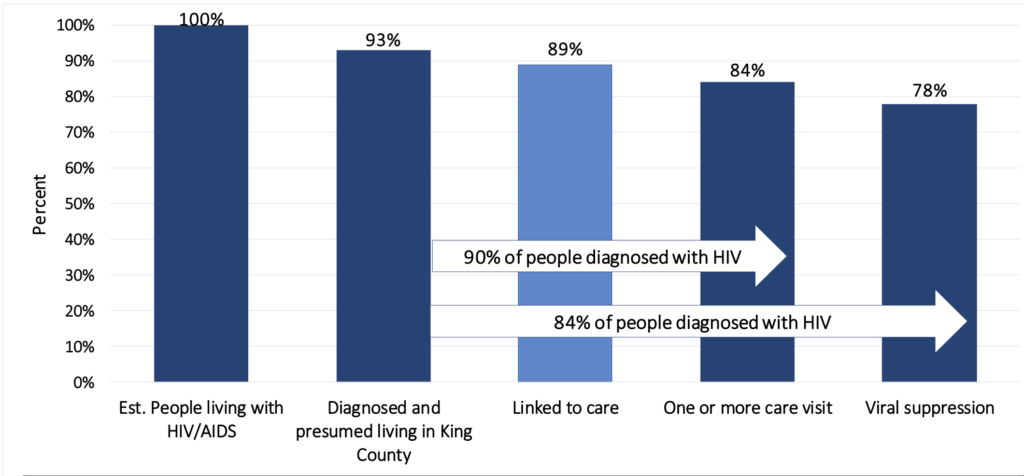
The state of HIV in King County
From Public Health Insider, Public Health – Seattle & King County
On the heels of this month’s World AIDS Day, this week we released our annual HIV/AIDS Epidemiology Report, a joint effort between Public Health – Seattle & King County and the Washington State Department of Health.
The report summarizes HIV epidemiological data and prevention efforts for our region in 2018. Below, we’ve outlined key highlights about the state of HIV in King County. Read the full report for more details and data.
Background
Over the last 30 years, King County has experienced a large epidemic of HIV infection that has been highly concentrated among men who have sex with men (MSM).
Since its inception, 10,415 people residing in King County have been diagnosed with HIV – including 8,042 (77%) MSM. Of this total number of cases, 1,118 people have died (11%) from the infection. The HIV epidemic has profoundly impacted the people of King County.
But King County has also risen to the challenge of HIV. King County has been successful in treating HIV infection, and was one of the first urban areas in the world to achieve the World Health Organization’s 90:90:90 goal: ensuring that at least 90% of infected persons know their HIV status, that 90% of infected people are treated, and that at least 90% of treated persons are virally suppressed.
Our area was also an early and successful adopter of syringe exchange and HIV preexposure prophylaxis (PrEP). Washington state had both the first PrEP drug assistance program and the first syringe exchange program in the United States, and the King County syringe exchange program is the largest in the country.
These interventions – the products of successful collaborations between communities affected by HIV, government, and medical and social services providers – led to a 50% decline in new HIV diagnoses in King County between 2008 and 2017.
In 2018, 90% of the approximately 7,000 persons with diagnosed HIV infection living in King County were engaged in care and 84% were virally suppressed, surpassing National HIV/AIDS Strategy goals.
An estimated 27% of sexually active MSM were on PrEP in 2018, and 49% of MSM and people who are at high risk for HIV were on PrEP, a 29% increase from 2017.

Emerging challenge: HIV among people who inject drugs
Despite the county’s history and continued success ensuring high levels of HIV treatment and widespread use of PrEP, the number of new HIV diagnoses in King County increased by 35% between 2017 and 2018 (219 new diagnoses in 2018 versus 162 in 2017), the largest one-year increase in new HIV diagnoses since 2002.
This increase was driven by a 400% jump in the number of new HIV diagnoses among people who inject drugs, with 25% of all new diagnoses in 2018 occurring in people who inject drugs (compared to 10% of new diagnoses in 2017).
As we discussed last year on the Insider, most of the increase in new cases occurred in people who are not MSM, particularly people who inject drugs who were living homeless, many of whom were women engaged in sex work. The occurrence of HIV in this population represents a shift in King County’s HIV epidemic.
This trend comes in the context of the nationwide opioid crisis, increasing rates of methamphetamine use, and high levels of homelessness in King County.
Given the complexities of engaging people who inject drugs in HIV testing and care services, in 2018 we saw small reversals in other previously encouraging population-level indicators of HIV prevention, including linkage to care and viral suppression, especially among people who inject drugs.
Racial disparities
The HIV epidemic in King County is also characterized by persistent racial and ethnic disparities. New diagnoses continue to disproportionately affect Black and Latinx populations.
Seven percent of King County residents are Black and 10% are Latinx, while 21% and 18% of new HIV diagnoses occurred among Black and Latinx populations, respectively.
The disproportionate impact of HIV on people who are Black is partly due to a higher prevalence of HIV among foreign-born Black residents. In King County, 43% of Black persons diagnosed with HIV in 2018 were foreign-born.
In better news, racial disparities in viral suppression continued to decline in 2018, with 80% viral suppression among people who are Black and living with HIV, 83% among people who are Latinx, and 85% among people who are white.
HIV prevention activities
In order to help reverse these trends, in 2018 King County expanded intervention and prevention activities aimed at the communities where we see the largest disparities:
- Syringe Service Programs exchanged approximately 8 million syringes in 2018 – an increase of 1 million compared to 2017. To our knowledge, King County distributes more syringes each year than any other city in the US.
- County government increased HIV testing services, including expanded outreach in north Seattle and increased testing in the downtown jail.
- Public Health and collaborating institutions continued to focus on linking people with HIV to care and treatment and building a stronger infrastructure to provide care to persons who have struggled to achieve and sustain viral suppression.
- Public Health and collaborating institutions have expanded programs to make condoms more available. This includes greater distribution of free condoms, mostly in economically disadvantaged communities in south King County, and distribution of a wider variety of condoms at Public Health’s STD clinic.
A renewed commitment to fighting HIV: an end in sight
“King County has made a huge amount of progress in the fight against HIV. Our success is a testament to our community’s ability to work together, to foster successful collaborations between people living with HIV, communities affected by HIV, medical and social service providers, and government,” explains Dr. Matthew Golden, the Director of the Public Health-Seattle & King County HIV/STD Program.
“But now we face a new challenge. We need to develop new approaches and new collaborations to confront a changing epidemic and ensure that every person with HIV infection knows their HIV status and is treated, and that prevention efforts reach everyone who needs them.”
As part of the federal End the HIV Epidemic initiative, starting in 2020 King County will be developing a new plan to decrease new HIV infections by 50% over the next 5 years.
This effort will engage people with HIV, community and diverse stakeholders to expand HIV prevention and treatment, eliminate the disparities that characterize the HIV epidemic, and finally end the epidemic that has affected our community for too long.
Report reference: HIV/AIDS Epidemiology Unit, Public Health – Seattle & King County and the Infectious Disease Assessment Unit, Washington State Department of Health. HIV/ AIDS Epidemiology Report & Community Profile 2019, Volume 88.


